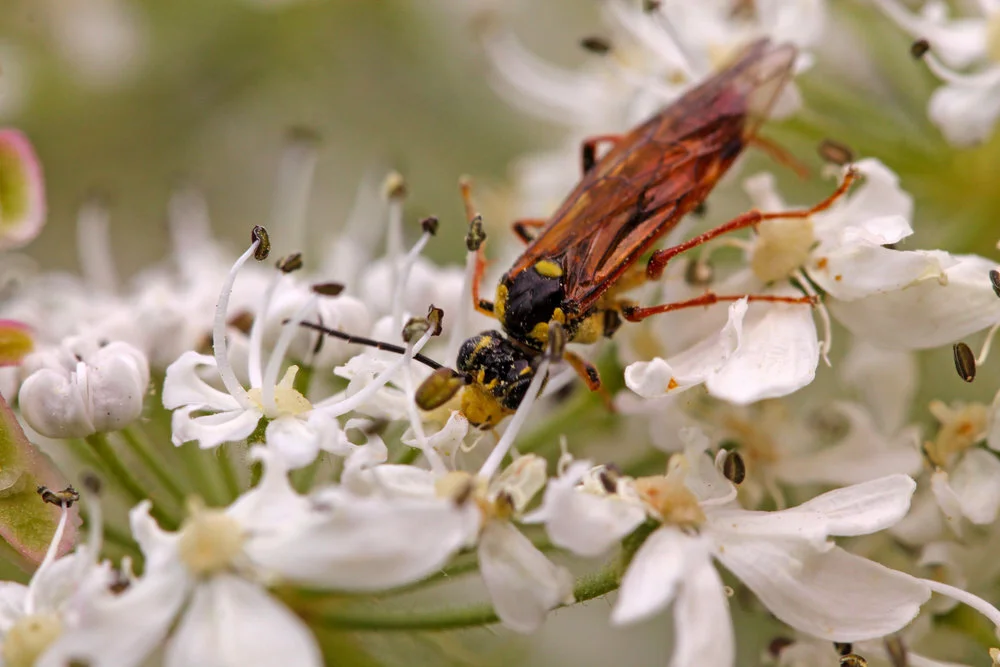And the beetles and the moths and the wasps and the bugs and, yes, even the mosquitoes...
This wasp pollinates as she searches for nectar on cow parsnip in Chilkoot Lake State Recreation Site in Alaska. (© Jared Bernard)
There has been a tremendous effort in recent years to raise public awareness about the decline of honeybees from Colony Collapse Disorder resulting from a combination of pesticides, agricultural practices, and climate change. In response, Greenpeace has launched a Bees in Decline outreach effort. Awareness campaigns like this one stem from the loss of apiculture -- the captive colonies of honeybees. The message to the public has been that honeybees, invariably portrayed as European honeybees (Apis mellifera) used worldwide in beekeeping, are the only source of pollination and that we are facing a global impact on crops and natural ecosystems as they decline (as in this USA Today article). The public quickly latched onto the cause. There was the Bee Movie starring Jerry Seinfeld, the #BringBacktheBees PR campaign by General Mills' Honey-Nut Cheerios cereal, another Save the Bees program by Cascadian Farms Cereals, and even a song by the sassy duo of Flo and Joan.
But hold on. Ecosystems around the world have flowers that have needed and received pollination for 200 million years, and they weren't the benefactors of European honeybees. How is that possible? The answer of course is that there is a massive number of bee species that have adapted to pollinate the multitude of flowering plant species. Many people are not aware that there are more species than the European honeybee and some sort of generic bumblebee, but there are at least 5700 true bee species (in the family Apidae). In the Hawaiian Islands, for instance, the European honeybee is an alien species that has escaped domestication and is likely displacing native bee species, such as the Hawaiian yellow-faced bees (in the family Colletidae). Almost two years ago, these Hawaiian yellow-faced bees received a status of Endangered from the US Fish & Wildlife. Although far less attention is being given to these other species of bees, research is showing that they too are in grave danger. The Center for Biological Diversity shows that in North America alone about half the bee species have populations that have a declining trend, and almost a quarter of them are facing extinction.
An endangered yellow-faced bee rests on a bench at Haleakala National Park on Maui. (© Jared Bernard)
Other sorts of bee-like creatures are also important pollinators, such as pollen wasps, fig wasps, and sweat bees (which pollinate cacti among other things). There are many others. And there are also obviously other species than bees and wasps that are pollinators, such the the vast diversity of moths and butterflies. These species too are in trouble. A long-term study of hawk moths in the northeastern US has revealed a serious decline.
If you wander through the aspen parkland forests in midsummer, you can't help but notice that an unimaginably vast number of pollinators are beetles. Even male mosquitoes are pollinators; only the females are after a blood meal to produce eggs. Last October, researchers in Germany published the results of their long-term large-scale study that demonstrated that overall insect biomass has declined by over 75% over the past three decades (summarized in this New York Times article from the end of last May). Alongside the other studies I mentioned, this points to a global loss of insects.
A mosquito pollinates a rare Cleome flower in southeastern Alberta. (© Jared Bernard)
Getting insects on the endangered species lists has been historically difficult because people are more sympathetic to the plight of mammals and birds. Butterflies might grab some public concern, and now bees from apiculture, but flies may go extinct without a glimpse. Part of that is also the fault of the researchers. Not only do researchers tend to study their favorite species, which often are not insects (causing a decline in entomologists), but also those that do study insects have lost the ability to identify them. This is a result of a loss of interest in taxonomy by the scientific community as the role of genetics has increased, a dangerous fallacy that removes the foundations of biology because we lose the ability to identify our specimens used in genetics studies. (There are many misidentified specimens in NCBI genetic repositories, causing a ripple effect of error.)
For the sake of salvaging the engines of the planet, the "Save the Bees" campaigns must be edited to "Save the Insects," and the public concern could engender funding for more insect diversity studies so we can know the true status of the global pollinator community.







